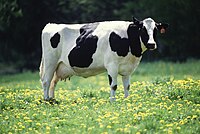
Photo from wikipedia
Abstract: As part of a cross-sectional survey, Canadian dairy producers were asked a set of questions to (1) determine factors that influenced them to continue using manual milk feeding (MMF)… Click to show full abstract
Abstract: As part of a cross-sectional survey, Canadian dairy producers were asked a set of questions to (1) determine factors that influenced them to continue using manual milk feeding (MMF) systems or to switch to automated milk feeding (AMF) and (2) investigate producers’ perceived advantages and disadvantages regarding both feeding systems. A total of 670 responses were received. Among respondents, 16% used AMF and 84% used MMF. The four most frequent factors that producers reported as important in motivating them to switch to AMF were to raise better calves, offer more milk to calves, reduce labor, and improve working conditions. For MMF farms, investment in equipment and group housing facilities, as well as farm size, were the primary reasons reported for their continued use of MMF systems. The principal perceived advantages of having an AMF were that calves are able to express natural behaviors and drink more milk without increased labor input. For MMF systems, the main perceived advantage was related to easier identification of sick calves. Results provide insights into factors affecting the choice of calf feeding methods by dairy producers, and improve understanding of producers’ needs and expectations regarding calf management and adoption of technology.
Journal Title: Canadian Journal of Animal Science
Year Published: 2017
Link to full text (if available)
Share on Social Media: Sign Up to like & get
recommendations!